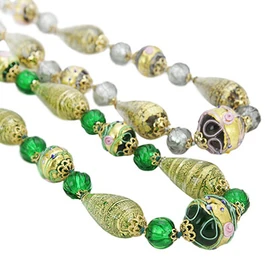The Story of the Most Famous Glass Art

Glass artisans from Murano, the center of the handmade glass industry, use different techniques to create their masterpieces, resulting in glass of various colors, textures, opacities, and designs. By far the most famous glassware, Millefiori Murano Glass, with its multitude of colors and mosaic effect, has captivated the world for centuries. Here, we will explain what Millefiori Murano Glass is, its history, enduring popularity, and its special value to both collectors and fans of Murano Glass.
The term ŌĆ£MillefioriŌĆØ translates from Italian as ŌĆ£a thousand flowers.ŌĆØ The glass is mosaic-like and features detailed patterns within every glass mosaic piece, most often flowers. The technique is rooted in ancient traditions and is known for the superior craftsmanship of the glassmakers.
Creating millefiori glass is a delicate and complicated procedure, perfected only by the best of the best glass artisans on the island of Murano. It is made by heating together a bundle of glass rods (called murrine) of various colors. Once the rods have fused, the bundle is thinned out into a single new rod and cut cross-sectionally, creating cylinder-shaped mosaic pieces with unique designs. These cylinders are then either arranged within a shape and fused together to create pendants, earrings, cufflinks, and more, or placed on different pieces of hot glass, such as Christmas ornaments, sculptures, tumblers, lamp shades, or vases.
Ancient Egypt
Millefiori Glass hails from Ancient Egypt and is over three thousand years old. It was originally called mosaic glass and was invented by the Egyptians as far back as 1400 B.C. They knew how to mix different colors of glass, but there arenŌĆÖt that many pieces that survived to our days. One example is in the Louvre, Paris, where you will find a chunk of detailed millefiori glass with the picture of a cow embedded in it. ┬Ā
The Roman Empire
The Roman millefiori objects date to between the 1st century B.C. and the 5th century A.D. when the glass masters of ancient Rome developed the technique for fusing together patterned glass pieces, but it isnŌĆÖt known if the Egyptians influenced them or not.┬Ā
The Romans created a variety of millefiori pieces, including beads and cups. The oldest well-preserved beads date to 50 B.C. ŌĆō 300 A.D.They also made half faces, based on characters from Greek and Roman theater.┬Ā
During the 7th and 8th centuries, it is likely that the Romans shared millefiori secrets with other countries in Europe. Millefiori glass rods have been found on archaeological sites in Ireland, dating to the 8th century. In addition, some millefiori jewelry has been found at the 7th-century Sutton Hoo Anglo-Saxon cemetery in England.┬Ā
The Dark Ages
The next few centuries are known as the Dark Ages. During this time, there was a cultural slump and an economic decline. Glass production disappeared, and techniques, including millefiori, were forgotten.
The Reinvention of Millefiori
In the 16th century, glass artisans from Murano tried to recreate some of the Ancient Roman millefiori art glass that had been discovered, but they had limited success, and the secret technique was lost once again.
It wasnŌĆÖt until the second half of the 19th century that interest in millefiori was revived, mainly due to the artisan, Vincenzo Moretti, whom we will look at later in more detail. He and other glassmakers were captivated by the Ancient Roman glasswork exhibited at the Murano Glass Museum, but it took trial and error for the technique to be recreated to perfection.┬Ā
Some of the superb millefiori art glass pieces from this time include vases, plates, urns, and bowls. They have either flower or abstract markings on both the outside and inside.┬Ā
Millefiori beads were also made and used in trading, mainly with Africa. They were traded for luxury goods such as gold and ivory, as well as palm oil.┬Ā
The Present Day
Millefiori Murano glass continues to be produced today and is of the highest standard. Because of this, other companies try to copy the technique, but although the items produced may be similar, the glassmakers do not possess the years of craftsmanship that the Murano artisans have.┬Ā ┬Ā┬Ā┬Ā
Vincenzo Moretti
Vincenzo Moretti was born in 1835 into a family of glassmakers and worked with glass from a very young age. He developed an intense passion for glassmaking and committed his life to the art. He was extremely talented and had a cultivated artistic taste.┬Ā
Moretti was an important figure in the Muranese Renaissance in the second half of the 19th century, and worked for Salviati & C. Glassworks in the mosaic enamel workshop. However, his fascination lay with the millefiori technique, and by sheer determination and never-tiring experimentation, he was finally able to recreate the Roman technique of millefiori. This led to increased interest in Murano art glass due to new and exciting colors and designs being created. Moretti became well-known both in Italy and in other parts of Europe.┬Ā
Despite being a great success in the craft of glassmaking, Moretti remained committed to his work and continued to experiment with new techniques. Not only did he rediscover millefiori art glass, but he was also able to create perfect copies of glassware used by the Ancient Romans and housed in the Archaeological Museum of Naples.┬Ā
Vincenzo Moretti died in 1901, but is still celebrated as one of the greatest glass artisans of all time.
Ercole Moretti
Ercole Moretti & Fratelli was established in 1911 by Ercole, Norberto, and Iginio Moretti, who planned to concentrate on producing two types of glass bead, the millefiori and the rosetta. They invented a technique called tumble fishing, which gives a glossy finish to artwork. Due to this, the companyŌĆÖs millefiori pieces are considered to be the most beautiful in the world.┬Ā
In 1968, the company created the murrina pendant, which remains popular even now. This pendant has become an important symbol of Murano glassmaking.
Today, the company is still going strong and is run by the descendants of the three brothers. They still create every piece of art glass by hand, their headquarters being divided into several industrial buildings in Murano. Their old workshop, which they used until the 1970s, has remained as it was and has been turned into a museum.┬Ā
Ercole MorettiŌĆÖs vintage jewelry is highly prized and is valuable, especially the African designs of the 1920s and the ethnic jewelry of the 1960s.┬Ā
The internet has made it easier to purchase Millefiori Murano glass, but with this comes the problem of whom to trust. Is the company selling genuine Millefiori pieces from Murano, or are their products fake?┬Ā
In recent years, there have been many counterfeits flooding the market despite millefiori art glass being notoriously difficult to copy. These companies may just paint the glass so that it looks like millefiori in photos, but it is nothing of the kind. Some create very sloppy millefiori designs with patterns ŌĆ£runningŌĆØ onto each other and not creating an aesthetically beautiful impression. Be careful, as these companies take money up front, and it can be difficult to get your money back once you receive the piece and discover that it is fake.┬Ā
If you are purchasing a Millefiori object in a physical store, it may be easier to spot a forgery, but this is not always the case, so you should still take precautions.┬Ā
These are some of the things you should look out for when intending to invest in a piece of millefiori Murano glass.
Authenticity Certificate or Signature of Artist
Many pieces of millefiori Murano glass objects come with an authenticity certificate, although this is not always the case. Some also bear the signature of the artist. ┬Ā┬Ā┬Ā┬Ā┬Ā
The Price
Millefiori glass comes at a price, so if you are offered a piece at a cost that seems too good to be true, it probably is.┬Ā
The Weight
Murano glass tends to be heavier than other types of glass due to the superior quality of the materials used. If the piece is very light, it probably isnŌĆÖt Murano art glass.
Colors and Design
Millefiori glass is distinguished by its distinctive, flower-like patterns, often featuring elaborate mosaic designs. The technique produces beautiful, richly colored pieces of glass and is particularly popular with glass connoisseurs. Watch out for the accuracy of the fusion of Millefiori beads and the aesthetic beauty of the designs. Fakes will not possess these qualities.
Research the Seller
With the internet, it is easier to find out more about glass sellers, so do some research before you buy. In addition, if you frequent glass exhibitions, you may meet other buyers who have had experience with different sellers and will point you in the right direction.
Design Elements and Artistic Value
The intricate patterns and vivid colors of Millefiori Murano glass are captivating and make a beautiful and elegant addition to any home. The pieces transcend time and suit both modern and classical decor, and never go out of style.┬Ā
Craftsmanship
Creating millefiori art glass requires great skill. It is one of the most challenging techniques used in Murano, and it showcases the talent of the glassmakers.┬Ā It requires extraordinary attention to detail, making each piece a collectible.
Value and Collectability
Millefiori is expensive and can increase in price over time because of the high demand for each piece. Because vintage millefiori sculptures, vases, and drinkware fetch a high price, they are an excellent investment. Collectors seek these pieces by glass artists such as Ercole Moretti because of the craftsmanship of the artisans and the historical significance of the technique.
Versatility
Millefiori Murano glass comes in various forms, for example, jewelry, vases, and paperweights. This means that a wide range of people with different interests will purchase the glass. In addition, many of the pieces are both functional and decorative, such as vases. Not only can you fill them with flowers, but they also look beautiful and will enhance the ambiance of any space.┬Ā
HIstorical Significance
Millefiori glass has a long and rich history going back to ancient times, which intrigues many people. The fact that it disappeared and was then revived, not once but twice, is also exciting and draws people in.┬Ā
Millefiori has certainly earned the title of being the most famous glass art in the world. Not only is it a technique that has an interesting and exciting history, but it also produces one of the most intricate and beautiful types of art glass to be found.





